Best Machine Learning Software For Data Analysis — Discover the top Machine Learning tools of 2025 to boost your data insights, streamline workflows, and drive smarter decisions with cutting-edge technology.
Machine learning software is transforming data analysis today. It helps uncover insights quickly and efficiently.
In this blog, we dive into the best machine learning tools available for data analysis. These tools make complex tasks easier, allowing businesses and researchers to handle large data sets with ease. With the growing need for accurate data interpretation, choosing the right software is crucial.
Whether you’re a beginner or an expert, understanding these tools can enhance your analytical capabilities. Get ready to explore software that can streamline your data analysis process and boost your decision-making. Let’s discover how these tools can help you make sense of vast data and improve outcomes.

Best Machine Learning Software For Data Analysis
Explore top machine learning software designed for data analysis. These tools simplify complex data tasks with powerful algorithms. Ideal for both beginners and experts, they offer user-friendly interfaces and insightful results.
Exploring machine learning software can be exciting for data enthusiasts. These tools help you analyze data more effectively, revealing hidden patterns and insights. Let’s dive into some top choices for data analysis.
Tensorflow
TensorFlow stands out for its versatility. It supports various machine learning models and neural networks. Here are some key features:
- Flexibility: Allows customization for different applications.
- Scalability: Handles large datasets efficiently.
- Wide community support: Offers numerous tutorials and resources.
Scikit-learn
Scikit-learn is great for beginners. This Python library simplifies machine learning tasks with easy-to-use functions. It offers:
- Comprehensive documentation: Guides users through its features.
- Built-in algorithms: Includes clustering, regression, and classification.
- Integration with other tools: Works well with NumPy and SciPy.

Pytorch
PyTorch is popular for deep learning tasks. It provides dynamic computation graphs that are easy to understand. Key advantages include:
- Dynamic graph construction: Simplifies debugging and development.
- Active community: Regular updates and active forums.
- Easy transition: Smooth integration for projects using TensorFlow.
Rapidminer
RapidMiner offers a powerful platform for data analysis. It requires no coding, making it accessible to all users. Highlights of RapidMiner include:
- User-friendly interface: Intuitive drag-and-drop functions.
- Extensive library: Includes many pre-built models.
- Automated processes: Reduces manual work in data preparation.
Knime
KNIME excels in data integration and visualization. It is an open-source tool that simplifies complex data workflows. Consider these features:
- Modular approach: Builds workflows using nodes.
- Rich visualization: Offers various charts and graphs.
- Integration capabilities: Connects with other data sources easily.
Weka
Weka is a comprehensive tool for data mining tasks. It offers a wide range of algorithms and visualization tools. Its features are:
- Easy setup: Quick installation and configuration.
- Algorithm variety: Includes decision trees, clustering, and more.
- Interactive interface: Helps users explore data visually.
Exploring these machine learning tools can enhance your data analysis skills. Each software offers unique features that cater to different needs. Choose the one that fits your project requirements best.

Best Machine Learning Software For Data Analysis Free
Discover top free machine learning software for data analysis. These tools simplify data insights and enhance understanding. Ideal for beginners and experts, offering user-friendly interfaces and powerful features. Enhance your data skills today.
Exploring machine learning software can be overwhelming. Especially if you’re on a budget. Thankfully, many free tools are available for data analysis. These options offer various features. They cater to beginners and experts alike. Below, we delve into some top free options.
Each tool has its own unique strengths. Choose one that fits your needs.
Knime
KNIME is a popular choice among data scientists. It offers a user-friendly interface:
- Drag-and-drop workflow: Simplifies complex data processes.
- Open-source: Free to use and modify.
- Wide community support: Access to forums and plugins.
Orange
Orange is another excellent tool for beginners. It combines simplicity with powerful features:
- Visual programming: Easy for non-programmers.
- Interactive data visualization: Helps in exploring data insights.
- Add-ons available: Extend functionality as needed.
Weka
WEKA provides a collection of machine learning algorithms. It’s great for those who want to experiment:
- User-friendly interface: Ideal for educational purposes.
- Comprehensive documentation: Guides users through processes.
- Supports various data formats: Works with CSV and ARFF files.
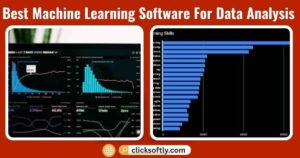
Scikit-learn
Scikit-learn stands out for its comprehensive library. It is perfect for Python enthusiasts:
- Integration with Python: Seamlessly works with other libraries.
- Rich algorithm collection: Covers classification, regression, and more.
- Active community: Frequent updates and improvements.
Tensorflow
TensorFlow offers flexibility for advanced machine learning projects. It’s a top choice for many developers:
- Extensive resources: Tutorials and guides available.
- Scalable platform: Suitable for both small and large projects.
- Open-source: Regularly updated by Google and community contributors.
Choosing the right tool depends on your specific needs. Evaluate these options to find the best fit. Each has its own set of features and benefits.
Gartner Magic Quadrant For Data Science And Machine Learning Platforms
Discover the best machine learning software for data analysis with Gartner’s Magic Quadrant. This trusted report evaluates top platforms, helping businesses choose the right tools for their data science needs.
Navigating the world of machine learning platforms can be daunting. Yet, the Gartner Magic Quadrant simplifies this process. It provides valuable insights into top platforms for data science. This guide helps businesses find suitable software to meet their needs.
Understanding The Gartner Magic Quadrant
The Gartner Magic Quadrant evaluates software based on two main criteria. These are completeness of vision and ability to execute. Let’s break it down with some key points:
- Completeness of Vision: Measures innovation and market understanding.
- Ability to Execute: Assesses performance and customer satisfaction.
Leaders In The Quadrant
Several platforms stand out in the leader category. These platforms excel in both vision and execution. Here are some noteworthy mentions:
- IBM Watson Studio: Known for robust analytics tools and AI support.
- Microsoft Azure ML: Offers seamless integration with other Microsoft services.
- SAS: Provides comprehensive data management and analytics solutions.

Challengers In The Quadrant
Challengers possess strong execution capabilities but have less visionary innovation. They often compete closely with leaders. Here are examples:
- TIBCO Software: Offers efficient data integration and analysis.
- Domino Data Lab: Focuses on collaboration and model management.
Visionaries In The Quadrant
Visionaries demonstrate innovative ideas but lag in execution. These platforms show potential for future growth. Some notable ones include:
- Dataiku: Known for cutting-edge machine learning features.
- RapidMiner: Provides user-friendly interface and advanced analytics.
Niche Players In The Quadrant
Niche players excel in specific areas but lack broad market appeal. They cater to specialized needs. Examples include:
- KNIME: Offers open-source solutions for data analysis.
- Alteryx: Known for data blending and preparatory tools.
What Is The Best Software For Data Analysis?
Choosing the best software for data analysis involves considering tools like TensorFlow and Scikit-learn. These platforms support machine learning tasks efficiently. They offer user-friendly interfaces for analyzing complex datasets.
Choosing the right tool for data analysis can be challenging. With so many options, it’s crucial to find software that suits your needs. Let’s explore some top choices that stand out in the field of machine learning.
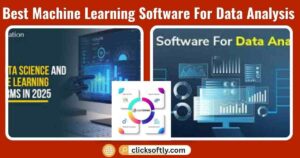
Python
Python remains a favorite among data analysts.
- Easy to learn: Python’s syntax is straightforward and user-friendly.
- Extensive libraries: Offers libraries like NumPy and Pandas for data manipulation.
- Versatile: Useful for web development, automation, and data analysis.
R
R is another robust option for data analysis.
R’s strength lies in its statistical capabilities. Many statisticians and data miners use R to develop data analysis software. It’s particularly favored in academia.
Matlab
MATLAB is known for its mathematical prowess.
- Strong visualization: Provides great tools for visualizing data.
- Comprehensive documentation: Offers detailed guides and resources for users.
- Engineering focus: Ideal for engineers and scientists due to its powerful tools.
Tableau
Tableau excels in data visualization.
Tableau transforms raw data into easy-to-understand visuals. It’s particularly beneficial for those who need to present data insights clearly and effectively.
Rapidminer
RapidMiner offers a comprehensive suite for data analysis.
- Intuitive interface: Easy for beginners to understand.
- Predictive analysis: Strong capabilities in forecasting and prediction.
- No coding required: Users can perform analysis without writing code.
Sas
SAS stands out in business analytics.
SAS provides advanced analytics, multivariate analysis, and predictive analytics. It’s widely used in large enterprises for its robust data management capabilities.

Which Software Is Best For Machine Learning?
Choosing the right software for machine learning data analysis can be tricky. TensorFlow offers flexibility for deep learning tasks, while Scikit-learn is great for beginners due to its simplicity. PyTorch’s dynamic computation graphs make it ideal for complex projects.
Choosing the right machine learning software can transform your data analysis. It’s essential to pick tools that suit your needs and skill level. Here, we explore some top options for machine learning software. Each has unique features that make it stand out.
Tensorflow
TensorFlow is widely used in the industry. It’s known for its flexibility and power.
- Open-source: Free to use with a vast community of developers.
- Scalability: Handles small to large-scale projects with ease.
- Versatile libraries: Offers libraries for various tasks like image processing and NLP.
Scikit-learn
Scikit-learn is perfect for beginners. It simplifies the machine learning process.
This Python library offers:
- Easy integration: Works well with other Python libraries like NumPy.
- Pre-built models: Includes models for regression, classification, and clustering.
- Simple syntax: User-friendly and easy to learn.
Keras
Keras is a high-level neural network API. It’s built on TensorFlow.
- Intuitive interface: Designed for fast prototyping.
- Modular: Easy to customize layers and models.
- Support: Backed by Google, ensuring regular updates.
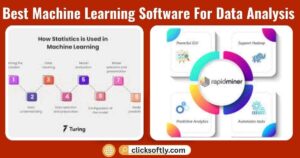
Pytorch
PyTorch is gaining popularity. It’s favored by researchers.
- Dynamic computation: Offers flexibility with dynamic graphs.
- Community-driven: Large community contributing to its development.
- Strong visualization tools: Facilitates debugging and understanding of models.
Rapidminer
RapidMiner is an all-in-one platform. It caters to users with varying expertise.
RapidMiner includes:
- No-code interface: Allows easy drag-and-drop model creation.
- Advanced analytics: Offers data prep and machine learning features.
- Collaborative tools: Supports teamwork with shared projects.
Knime
KNIME is known for its open-source analytics platform. It’s user-friendly and effective.
- Visual workflow: Uses a drag-and-drop interface for simplicity.
- Integration: Combines with other tools like R and Python.
- Extensive extensions: Offers plugins for text mining and image processing.
Each software has its strengths. Consider your specific needs and project requirements.
Can Machine Learning Be Used For Data Analysis?
Machine learning software helps analyze data efficiently. It identifies patterns and trends in large datasets. Tools like TensorFlow and Scikit-learn offer powerful solutions for complex analysis tasks.
Machine learning transforms data analysis today. It offers new methods to extract insights from complex datasets. This makes it a powerful tool for businesses and researchers alike. Understanding how machine learning enhances data analysis is key to leveraging its full potential.

Benefits Of Machine Learning In Data Analysis
Machine learning offers many advantages for data analysis. Let’s explore some key benefits:
- Automation: Machine learning automates data processing, reducing manual tasks.
- Pattern Recognition: It identifies patterns and trends in large datasets.
- Predictive Analysis: Machine learning predicts outcomes using historical data.
- Scalability: It handles vast amounts of data efficiently.
- Accuracy: Algorithms improve accuracy over traditional methods.
Machine Learning Techniques For Data Analysis
Various techniques enhance data analysis through machine learning. Each offers unique capabilities.
- Supervised Learning: Uses labeled data to train models for specific predictions.
- Unsupervised Learning: Identifies hidden patterns without pre-existing labels.
- Reinforcement Learning: Learns by interacting with environments and receiving feedback.
- Deep Learning: Utilizes neural networks to analyze complex data structures.
- Ensemble Methods: Combines multiple models to improve overall performance.
Real-world Applications Of Machine Learning In Data Analysis
Machine learning is applied across many fields for insightful data analysis. Here are some examples:
- Healthcare: Predicts patient outcomes and diagnoses diseases.
- Finance: Detects fraudulent activities and forecasts market trends.
- Retail: Optimizes inventory management and personalizes customer experiences.
- Marketing: Analyzes consumer behavior for targeted advertising.
- Transportation: Enhances route optimization and traffic management.
Machine learning continues to reshape data analysis. Its applications are vast and evolving. Exploring these possibilities opens doors to innovation and efficiency in various industries.
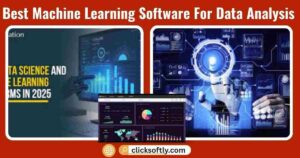
Frequently Asked Questions
What Is The Best Software For Data Analysis?
The best software for data analysis includes Python, R, and Excel. Python is versatile with libraries like Pandas. R is ideal for statistical analysis and visualization. Excel is user-friendly for basic analysis and data manipulation. Each tool offers unique benefits depending on your specific data analysis needs.
What Is The Best Ai Tool For Analyzing Data?
The best AI tool for data analysis is often considered to be IBM Watson. It offers advanced analytics, machine learning capabilities, and visualizations. Other popular options include Google Cloud AI and Microsoft Azure AI, known for their scalability and robust features.
Choose based on specific requirements and budget.
What Is The Best Software For Machine Learning?
TensorFlow, PyTorch, and Scikit-learn are top machine learning software choices. TensorFlow offers flexibility and scalability. PyTorch is popular for dynamic computation and deep learning. Scikit-learn is ideal for beginners and classic ML algorithms. Choose based on project needs and expertise level.
Can Machine Learning Be Used For Data Analysis?
Yes, machine learning can analyze data efficiently. It identifies patterns, predicts trends, and improves decision-making processes. By leveraging algorithms, it processes large datasets swiftly, offering valuable insights. Machine learning tools enhance accuracy and speed in data analysis, making them indispensable in various industries.
Conclusion
Choosing the right machine learning software is crucial for data analysis. Each software offers unique features to fit different needs. Free options provide a great start for beginners. Explore the Gartner Magic Quadrant for expert insights. Consider your goals and resources when selecting a tool.
Machine learning enhances data analysis by uncovering patterns. It’s an evolving field with exciting possibilities. Start experimenting today with the best software for your needs.
Stay curious and keep learning. The world of data analysis awaits your exploration.


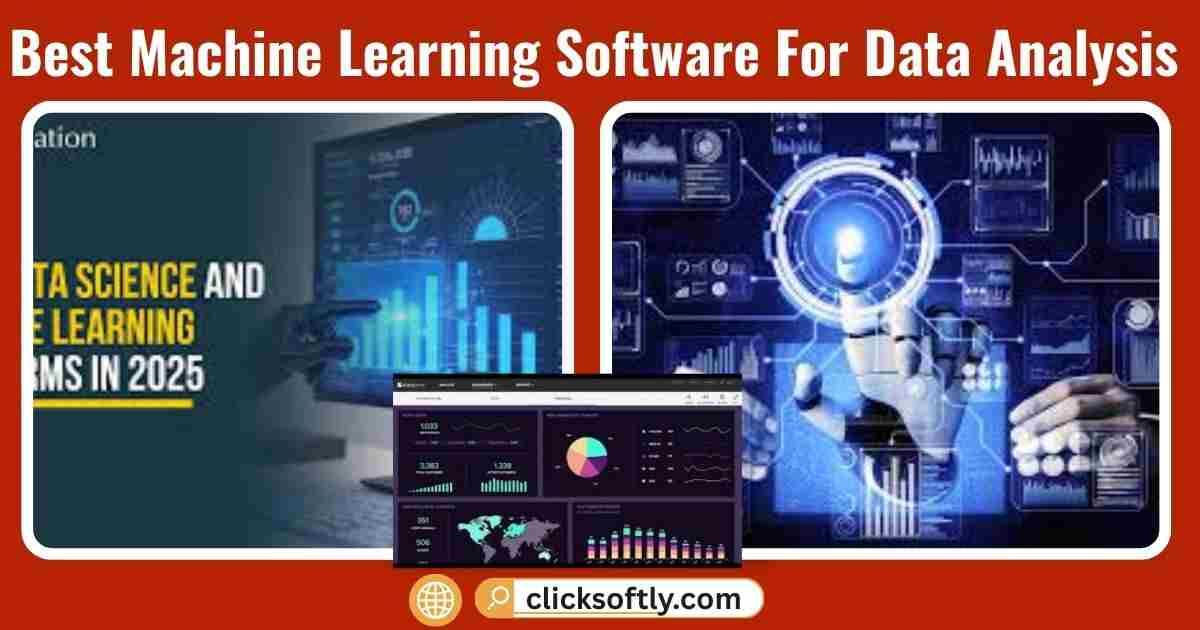
Leave a Reply